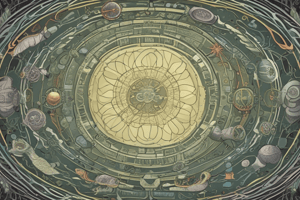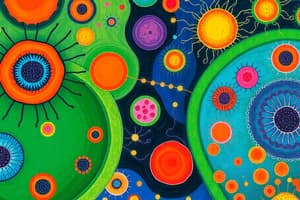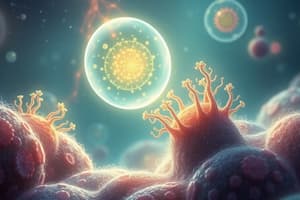Podcast
Questions and Answers
What is the primary mechanism by which mitochondria are believed to have evolved?
What is the primary mechanism by which mitochondria are believed to have evolved?
- Through the mutation of a eukaryotic gene
- Through the engulfment of an aerobic prokaryote (correct)
- Through the engulfment of an anaerobic prokaryote
- Through the fusion of two eukaryotic cells
Which of the following protist groups does NOT have mitochondria?
Which of the following protist groups does NOT have mitochondria?
- Parabasalids
- Diplomonads (correct)
- Euglenozoans
- Giardia
What is the current understanding of the relationships among protist groups?
What is the current understanding of the relationships among protist groups?
- They are well-established and changing rapidly
- They are well-established and unchanging
- They are poorly understood and changing rapidly (correct)
- They are poorly understood and stable
What is the name of the photosynthetic organelle that is believed to have evolved from a cyanobacterium?
What is the name of the photosynthetic organelle that is believed to have evolved from a cyanobacterium?
Which of the following is a characteristic of Diplomonads?
Which of the following is a characteristic of Diplomonads?
Which of the following is NOT one of the four supergroups of eukaryotes?
Which of the following is NOT one of the four supergroups of eukaryotes?
What is the primary characteristic that distinguishes Euglenozoa as a clade?
What is the primary characteristic that distinguishes Euglenozoa as a clade?
Which of the following is a characteristic of kinetoplastids?
Which of the following is a characteristic of kinetoplastids?
What is the proposed endosymbiont that led to the origin of the supergroup SAR?
What is the proposed endosymbiont that led to the origin of the supergroup SAR?
Which of the following protists is known to cause sleeping sickness in humans?
Which of the following protists is known to cause sleeping sickness in humans?
What is the function of the alveoli in the sub-group Alveolata?
What is the function of the alveoli in the sub-group Alveolata?
Which of the following is a characteristic of dinoflagellates?
Which of the following is a characteristic of dinoflagellates?
What is the term for the phenomenon caused by dinoflagellate blooms?
What is the term for the phenomenon caused by dinoflagellate blooms?
Which of the following is NOT a subgroup of Alveolata?
Which of the following is NOT a subgroup of Alveolata?
What is the primary function of the apicomplexan's apex?
What is the primary function of the apicomplexan's apex?
Which protist group is characterized by the presence of cilia for movement and feeding?
Which protist group is characterized by the presence of cilia for movement and feeding?
Which of the following is NOT a characteristic of diatoms?
Which of the following is NOT a characteristic of diatoms?
What is the primary mode of reproduction in diatoms?
What is the primary mode of reproduction in diatoms?
Which apicomplexan parasite causes malaria?
Which apicomplexan parasite causes malaria?
What is the name of the sediments composed of fossilized diatom walls?
What is the name of the sediments composed of fossilized diatom walls?
Which of the following is a characteristic of Stramenopiles?
Which of the following is a characteristic of Stramenopiles?
What is the estimated annual death toll from malaria?
What is the estimated annual death toll from malaria?
Flashcards are hidden until you start studying
Study Notes
Endosymbiosis and Protist Evolution
- Endosymbiosis is the process where a unicellular organism engulfs another cell, which becomes an endosymbiont and eventually an organelle in the host cell.
- Mitochondria are believed to have evolved by endosymbiosis of an aerobic prokaryote.
- Plastids are believed to have evolved by endosymbiosis of a photosynthetic cyanobacterium.
Protist Diversity
- The relationships among protist groups continue to change rapidly.
- One hypothesis divides all eukaryotes (including protists) into four supergroups.
Excavates
- Some members have a feeding groove that appears like “excavated” from the surface.
- This group includes diplomonads, parabasalids, and euglenozoans.
Diplomonads
- Have modified mitochondria called mitosomes.
- Derive energy from anaerobic biochemical pathways.
- Have two equal-sized nuclei and multiple flagella.
- Are often parasites, such as Giardia intestinalis (also known as Giardia lamblia).
Parabasalids
- Have reduced mitochondria called hydrogenosomes that generate some energy anaerobically.
- Include Trichomonas vaginalis, the pathogen that causes yeast infections in human females.
Euglenozoa
- A diverse clade that includes euglenids and kinetoplastids.
- Some are predatory heterotrophs, photosynthetic autotrophs, and parasites.
- Main feature is a spiral or crystalline rod of unknown function inside their flagella.
Kinetoplastids
- Have a single mitochondrion with an organized mass of DNA called a kinetoplast.
- Include free-living consumers of prokaryotes in freshwater, marine, and moist terrestrial ecosystems.
- This group includes Trypanosoma gambiense, which causes sleeping sickness in humans, and pathogenic trypanosomes that cause Chagas’ disease.
SAR
- Some data suggest that the supergroup SAR is monophyletic and originated by a secondary endosymbiosis event.
- The proposed endosymbiont is a red alga.
- This clade is controversial and includes the alveolates and the stramenopiles.
Alveolata
- Members have membrane-bounded sacs (alveoli) just under the plasma membrane.
- Function of the alveoli is unknown.
- Includes dinoflagellates, apicomplexans, and ciliates.
Dinoflagellates
- Have two flagella and each cell is reinforced by cellulose plates.
- Abundant components of both marine and freshwater phytoplankton.
- Diverse group of aquatic phototrophs, mixotrophs, and heterotrophs.
- Toxic “red tides” are caused by dinoflagellate blooms.
Apicomplexans
- Parasites of animals, and some cause serious human diseases.
- Spread through their host as infectious cells called sporozoites.
- One end, the apex, contains a complex of organelles specialized for penetrating host cells and tissues.
- Most have sexual and asexual stages that require two or more different host species for completion.
- Plasmodium is the parasite that causes malaria.
Ciliates
- A large and varied group of protists.
- Named for their use of cilia to move and feed.
- Have large macronuclei and small micronuclei.
- Genetic variation results from conjugation, in which two individuals exchange haploid micronuclei.
Stramenopila
- Includes important phototrophs as well as several clades of heterotrophs.
- Most have a “hairy” flagellum paired with a “smooth” flagellum.
- Includes diatoms, golden algae, brown algae, and oomycetes.
Diatoms
- Unicellular algae with a unique two-part, glass-like wall of hydrated silica.
- Major component of phytoplankton and highly diverse.
- Fossilized diatom walls compose much of the sediments known as diatomaceous earth.
Studying That Suits You
Use AI to generate personalized quizzes and flashcards to suit your learning preferences.




